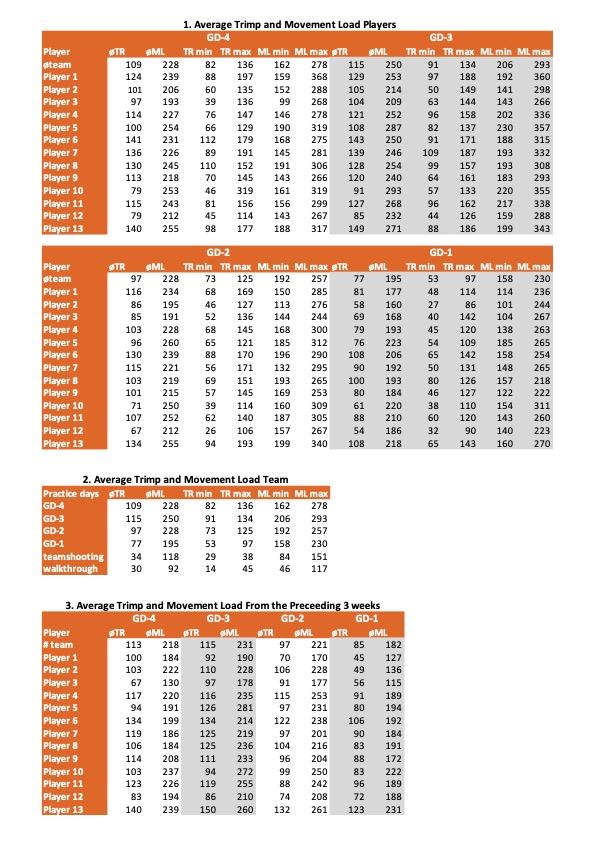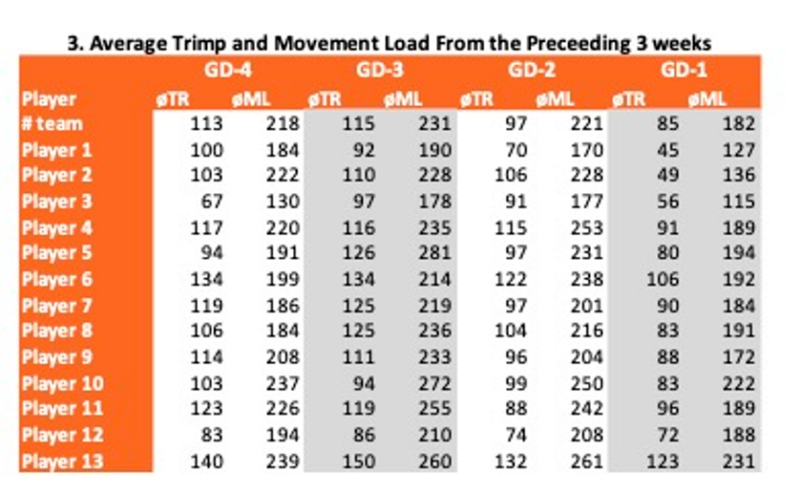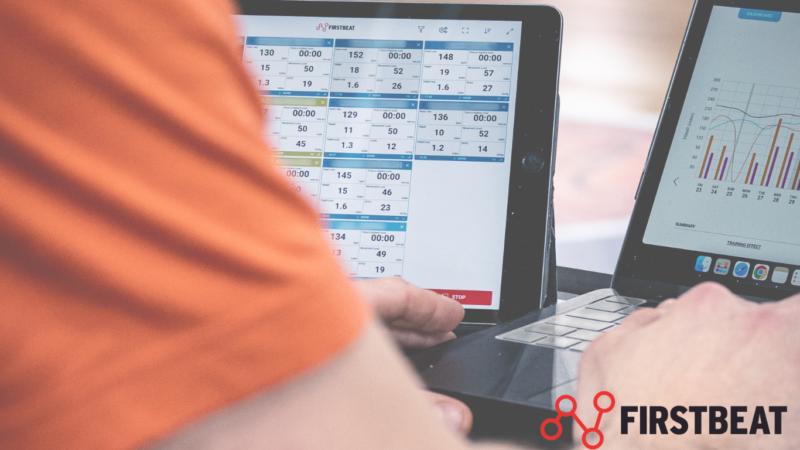
This article is written by Domenik Theodorou, a Firstbeat Sports client and Performance Coach at RASTA Vechta, a professional basketball team competing in the Basketball Bundesliga (BBL). Prior to his current role, Domenik also worked at Bamberg Baskets and BG Göttingen. In this article, Domenik sheds light on his approach to structuring historical Firstbeat training data.
In the following article I aim to detail my strategy for effectively organizing various historical Firstbeat parameters. This method is designed to empower me to make more informed decisions during real time monitoring of team practices.
Why is athlete real time monitoring important?

Live monitoring provides real time data on athlete’s physiological responses to training which allows coaches to make immediate adjustments if necessary. This way you can finetune training to individual needs.
If you monitor training load consistently it is easier for you as a coach to identify signs of overtraining, fatigue or potential risk of injury.
Developing a strategy for organizing your data puts yourself in a better position to determine whether the current training load is too low, too high or falls within the range that each athlete is accustomed to.
In one of my previous blog posts I highlighted the variance in how players quantify training load. To improve decision-making during live monitoring, it is essential to have access to the historical training data of each player. This enables intra-individual comparisons and improves your ability to make educated decisions on the fly during team practice.
Before I get into the details of how I organize my data, let me give you a quick overview of the key Firstbeat parameters I use.
Which parameters do I follow during real time monitoring?
During live monitoring, I thoroughly analyze TRAINING IMPULSE (TRIMP), MOVEMENT LOAD (ML), EXCESS POST-EXERCISE OXYGEN CONSUMPTION (EPOC), HEART RATE (HR), and HIGH INTENSITY TRAINING (HIT)/ time in highest zone. Additionally, I occasionally assess TRIMP/min, Peak Heart Rate or %HR max.
In the early stages of incorporating Firstbeat into my analysis, I primarily focused on the aforementioned metrics to gain a deeper understanding of how the players internally responded to the demands of practice.
In my initial review of the training data, I noticed parallels with Christie Aschwanden’s findings in her book “Good to Go”. Athletes respond characteristically but idiosyncratically to training. Put simply, athletes vary in their response to training, meaning each individual possesses their own physiological fingerprint.
With this in mind, I wanted to come up with a strategy to enhance my real-time data interpretation. This led me to develop an overview of historical reference data for each player.
Historical training data overview

Figure 1 Historical Training Data
Figure 1 presents the historical training overview that I personally designed for our context. Part 1 provides a summary of player and team average TRIMP and ML data across different practice days (GD-4, GD-3, GD-2, GD-1) starting from the regular season. Additionally, it shows the minimum and maximum values of TRIMP and ML for each practice day.
Part 2 of Figure 1 illustrates similar information but exclusively for team averages. It also includes average values for team shooting sessions and walkthroughs on game days.
While the first two segments of Figure 1 provide training data from the entire regular season, the third table specifically covers the data from the preceding three weeks. Imagine you are at the end of March in the season; what you did in September matters less than what you did during the first weeks of March. This is why the last section is very important for live monitoring.
I bring this paper to every practice session and update it daily. The training data collected in this overview covers 7 months of the regular season.
Benefits of having historical training data present during practice
Just a quick look at Figure 1 confirms what I mentioned above and in my previous blogpost. It highlights the wide range of ways how players generate training data. Having this overview available during team practices enables you to put the various metrics of each athlete in better context. In professional sports, you constantly look for signals. If you have the opportunity to notice deviations in certain parameters from their “typical norms”, I believe it is crucial to pay attention and investigate further.
Let me give you an example by examining Player 10 on GD-1. On that particular day, his average TRIMP (61) usually falls below the team’s average TRIMP (77). During the season, there was one occasion on GD-1 where this player showed a TRIMP of 43, and this occured only after the warm-up and a single shooting drill. Just by glancing at my tablet, I could immediately see that his TRIMP was significantly higher than that of the rest of the team. If you pay close attention to your players’ training data, you can notice spikes even without having a comprehensive overview in front of you. But in the heat of the moment during practice, it is simply not possible to have all of your players’ “typical” data memorized. A quick look at my sheet of historical practice load provided confirmation that something was off.
During the next water break I approached him and simply asked if everything was alright. It turned out that he had trouble falling asleep and ended up oversleeping, rushing to practice without having breakfast. We adjusted his workload for that practice to ensure he would be prepared to play the next day. This incident is particularly noteworthy because if I had relied solely on the eye test, I wouldn’t have even thought to ask him if he was ok.
Let me give you another example by examining the training data from Player 13. Regardless of the practice day you check, his TRIMP and ML values consistently surpass the team average. If you lack this specific information and notice during live monitoring that he repeatedly records the highest TRIMP compared to everyone else, one might reasonably conclude that he is not in optimal physical condition. Before you draw any conclusions it is essential to recognize that he may accumulate TRIMP at a faster rate than others, but the same applies to his ML as well.
Further investigation into his data post practices also revealed consistently high heart rate recovery rates. From a physiological standpoint, high heart rate recovery rates indicate enhanced exercise capacity in my view. I would certainly delve deeper into the matter if this player consistently showed both high TRIMP scores and persistently low recovery heart rates.
In review, I would suggest that he not only elevates his heart rate quickly but also demonstrates the ability to recover rapidly – a great example of how everyone possesses their own unique physiological signature. In my opinion, this perfectly illustrates the importance of contextual information and underscores the preference for intra-individual over inter-individual comparisons.
Practice data of the preceeding three weeks

During live monitoring, Section 3 of Figure 1 typically undergoes the most scrutiny. My objective is to maintain our training load within certain limits across various practice days.
By comparing current practice data to the preceding 3 weeks I can ensure that any increases or decreases are gradual and stay within manageable limits.
Prevention of detraining
Prevention of detraining is one of my top priorities. When comparing Player 3’s values from the previous three weeks to his season averages, a notable decrease in practice exposure becomes apparent. You might observe this trend by simply checking your tablet during live monitoring, but without context, its significance could be overlooked. This player has fallen out of the rotation and is spending less time actively participating in training sessions.
As a performance coach, my responsibility is to ensure that all our players are consistently prepared to perform at their best. Top-up sessions offer an excellent opportunity to maintain this player’s readiness for action when called upon. These sessions are flexible and rely on the player’s current level of practice participation. If a player’s ML significantly lags behind the team average, we need to address this gap through an individual workout with one of our assistant coaches after practice.
To determine the amount of practice load the player needs to make up post-practice, I rely on a combination of common sense and insights from Figure 1 to guide my decision-making. This approach allows me to recommend a specific ML goal to our assistant coaches for conducting a top-up session, typically ranging from 10 to 20 minutes. Is this approach flawless? Perhaps not, but it works within our environment. When communicated effectively, it has the potential to keep the player prepared for action.
The Wild West

In the world of professional sports, it can feel like the Wild West sometimes – things rarely go as planned and the lines between success and failure can get blurry. But even in the chaos, a little bit of direction can go a long way.
By consistently monitoring your players and fine-tuning your understanding of how each athlete accumulates training load, you empower yourself by making the unpredictable a little bit more manageable. This includes recognizing whether someone is over- or undershooting during practice sessions as well as identifying potential risks.
Access to historical data enables you to cross-reference and validate the information gathered during live monitoring, enhancing the accuracy and reliability of your evaluations. In simpler terms, an athlete management platform such as Firstbeat can further sharpen the blurred lines, providing enhanced guidance for decision-making.
If you’re interested in learning more about how I incorporate Firstbeat as a daily screening tool throughout the season to identify fitness trends in our players, you can explore the details in my initial blog post available here.
To delve deeper into my utilization of Firstbeat for Return to Competition processes, feel free to examine another article available here.
I am always happy to connect and chat about S&C work. Please send me a message on Instagram @domceps if you would like to connect.
Want to get more Firstbeat insights from Domenik? Be sure to check out our webinar recording – Mastering Data Driven Decision Making in Pro Basketball.
References:
- Aschwanden, C. (2019). Good to go: What the athlete in all of us can learn from the strange science of recovery. New York: W. W. Norton & Company.
If you liked this article, you should subscribe to our newsletter.
You might also be interested in

How to Maximize Use of Firstbeat During Return to Competition
In this article, I’ll outline my strategy for RTC processes and elaborate on how I use Firstbeat to improve decision-making during this phase. I categorize RTC into “off-court” and “on-court” rehab

How I Use Firstbeat in Professional Sports to Identify Trends in Players’ Fitness
This article is written by Domenik Theodorou, a Firstbeat Sports client and Performance Coach at RASTA Vechta, a professional basketball team competing in the Basketball Bundesliga (BBL). Before his current…

Not Monitoring Internal Load is Like Cooking Without a Recipe – Here’s Why
In this sports-focused blog post, Firstbeat’s Customer Success Manager, Joel Wenning, examines the importance of internal load and why this data should be the priority when it comes to athlete…

